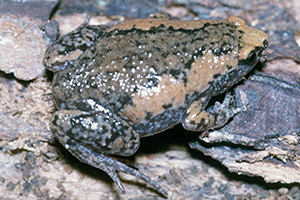Gastrophryne carolinensis
The toxic skin secretions of these toads protect them from many kinds of predators and may deter ant attacks as the toads forage near ant mounds. Skin secretions also help the male cling to the female while mating.
Photo Credit: Sturgis McKeever, Georgia Southern University, Bugwood.org. Creative Commons Attribution-Noncommercial 3.0 United States (CC BY-NC 3.0 US) License;
Gastrophryne carolinensis
Common Name: eastern narrow-mouthed toad
Other Common Names: eastern narrowmouth toad
Animal Guild: Amphibian
Class > Order > Family: Amphibia > Anura > Microhylidae
What does the species look like?
Eastern narrow-mouthed toads are gray, brown, or reddish on top, often with dark spots, patches, or mottling, and often with a broad stripe on each side of the back. These toads have relatively smooth skin, short limbs, unwebbed toes, and a pointed snout. A fold of skin extends across the back of the head. Maximum snout-vent length is 1.5 inches (3.8 cm). Adult males have a dark throat (light in female). Larvae have fleshy lips, with a notch in the middle of the upper lip (beaklike mandibles and labial teeth are absent); the head and body are flattened, the eyes are at the sides of the head when viewed from above. The tail fins are low, clear, and have dark pigment along the margin of the tail musculature. Larvae grow up to 1.2 inches (3 cm) in total length. Egg masses consist of a thin gelatinous film containing up to several hundred eggs at the surface of the water.
Where is the species found?
States & Provinces
AL, AR, FL, GA, IL, KS, KY, LA, MD, MO, MS, NC, OK, SC, TN, TX, VA
Distribution
Range extends from southern Maryland to southeastern Kansas, and south to the Florida Keys, Gulf Coast, and eastern Texas. Scattered disjunct populations occur along the northern and western margins of the range. This species has been introduced on the Little and Great Bahama banks, and on Grand Cayman Island (Cayman Islands), where it is very abundant.
Eastern narrow-mouthed toads occur a wide variety of habitats, usually in areas with sandy or loamy soils. On land, they range up to several hundred meters from water. Breeding sites include lakes, ponds, sloughs, flooded roadside ditches, swamps, stream margins, rain puddles, etc., in both temporary and permanent waters. Males call from sheltered locations, often from beneath objects at the water's edge or partially buried in grass.
General Phenology and Life History
These little toads are most active at night during wet weather of spring and summer. They burrow underground or hide beneath objects in daytime and when conditions are cold or dry. Breeding occurs usually after heavy rains, mostly in spring and summer but as early as March or as late as November. Aquatic larvae hatch from floating jelly in a couple days and metamorphose into the terrestrial form in about 3-10 weeks.
Which phenophases should I observe?
Do you see/hear...?
Activity
Adults on land More...
For abundance, enter the number of individual animals observed in this phenophase.
Adults in water More...
For abundance, enter the number of individual animals observed in this phenophase.
Adults feeding For abundance, enter the number of individual animals observed in this phenophase.
Reproduction
Vocalizing What is the intensity of vocalizing?
Single calls: There is space between calls and individuals can be counted. Overlapping calls: Calls of individuals can be distinguished but there is some overlapping of calls. Full chorus: Calls are constant and overlapping.
Mating For abundance, enter the number of individual animals observed in this phenophase.
Fresh eggs For abundance, enter the number of individual animals observed in this phenophase.
Development
Dead adults For abundance, enter the number of individual animals observed in this phenophase.
What do these phenophases look like?
There is currently no photoguide available for this species. If you'd like help us create one, use the guidance document and species template provided here . Then send it via email to education@usanpn.org when it is complete.
